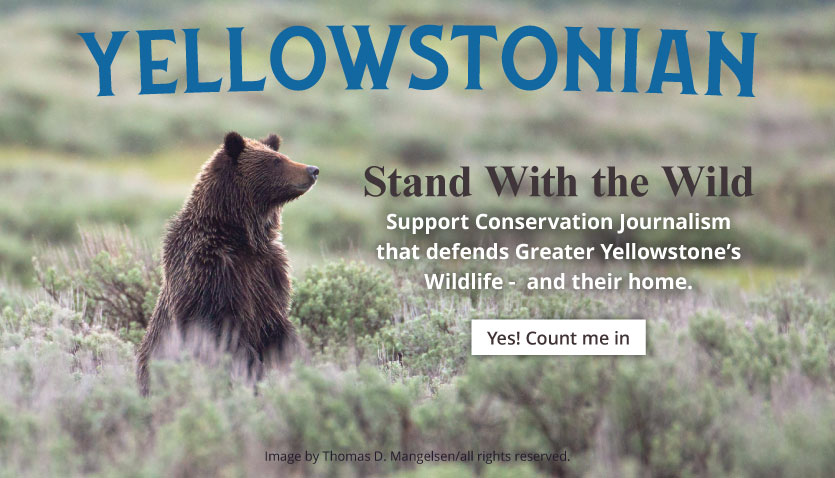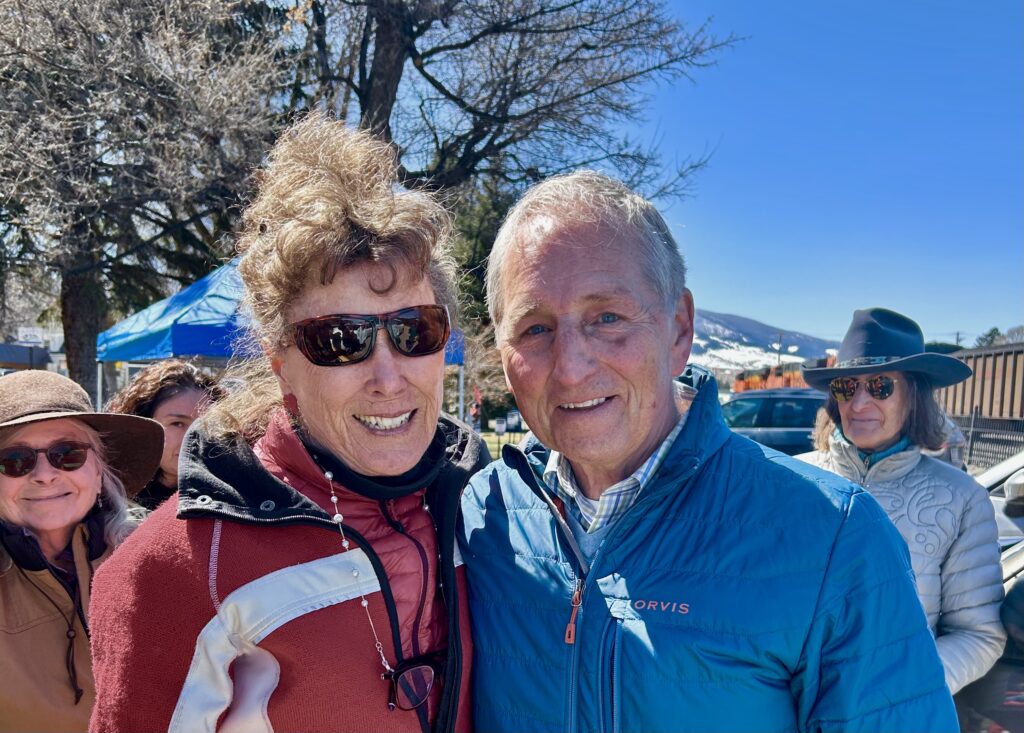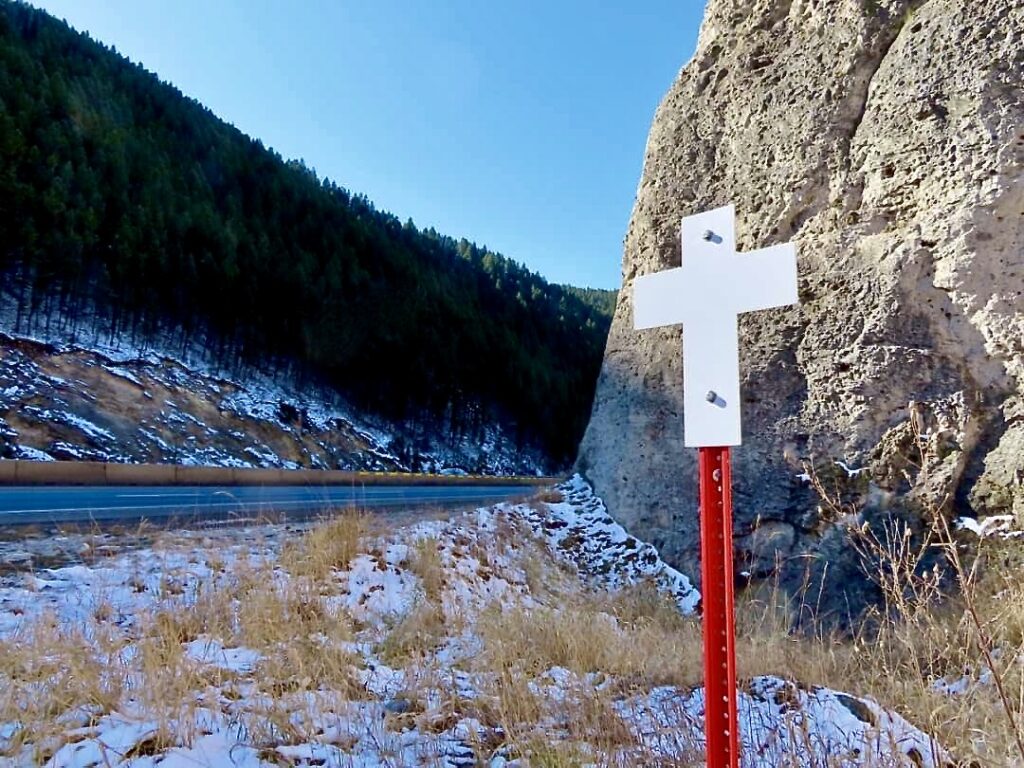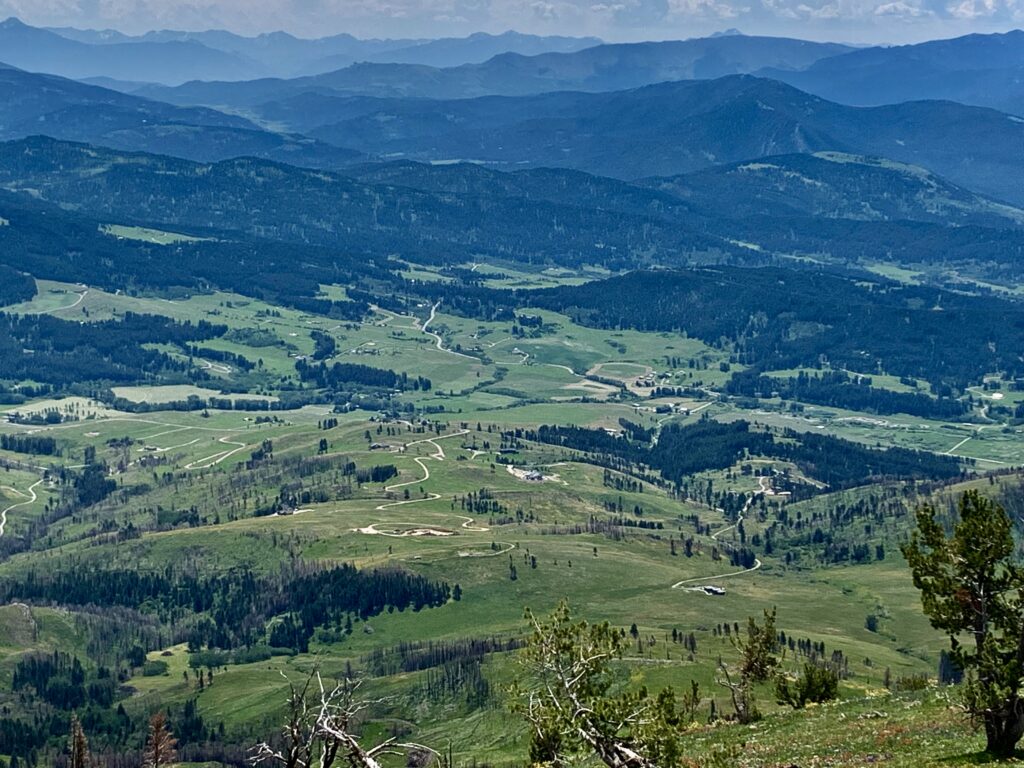(1996-2024)
A Remembrance
The story below appeared in spring 2024
by Todd Wilkinson
You may have heard by now that Grizzly 399 has wandered out of the wild hinters of Jackson Hole for another year, and she’s again re-entered our human-dominated world. Her appearance, a kind of encore for a bear that has led an extraordinary long life, is accompanied by a cub, a yearling born in 2023 when 399 was 27—the equivalent in bear years of being an aging senior citizen with child.
The fact that she’s reached the upper limits of grizzly bear senescence has, for a few years now, created a sense of resignation that she’s on borrowed time. Every recent spring has been one of waiting and expectation, with few of her fans wanting to reflect hard on the approaching inevitability. And yet, in this extended meanwhile, the coming busy months of 2024 will be another opportunity to observe, heed the lessons she’s offered and apply them to what has become growing appreciation for the value of grizzly bear conservation.
To call 399 “the most famous living grizzly bear” on Planet Earth grabs our attention, and it speaks foremost to modern society’s fascination with flash-in-the-pan celebritydom, which is actually a superficial fetish often assigned to humans lacking substance.
I’ve been guilty as a journalist invoking it as a reference point though always done with a motive of getting readers to pay attention to what has been a miraculous existence. When Dr. Charles Schwartz, then head of the Interagency Grizzly Bear Study Team, first mentioned to me a radio-collared bear in 2005 that his researchers were tracking in Jackson Hole, and that it was a female assigned the number 399, there was little reason to future-trip on what would transpire.
Back then, grizzlies were largely nameless, faceless, elusive animals, having a high level of human fear factor associated with them. Often, they were referenced “as being part of a larger population” in which total numbers matter more than individuals. The nature of grizzlies themselves made it difficult to craft narratives allowing readers to better relate to their plight. People do not relate generically to populations; they have revelations through the stories of individual animals.
To gather color for my magazine piece, which was intended to provide an overview of proposed grizzly bear delisting—i.e. removing the Greater Yellowstone griz population from federal protection—Schwartz and I followed GPS coordinates to a spot in the Bridger-Teton National Forest above Pilgrim Creek where 399 had been a few weeks before. It was a place she had departed from and so we wouldn’t be disturbing her.
On that day, we stopped beside a matted patch of grass 399 had used as a daybed, a tiny piece of ground where she relaxed. Looking back now, I wonder if she had had any dreams and what they might have entailed. Could she have possibly foresaw the next 19 years?
The next spring, she emerged from the den with three cubs and the study team gave them numeric identities. There were sisters 610 and 615 and brother 587. The foursome was spotted infrequently by wildlife watchers, but 399 had not yet attracted a significant human following because she and her troop were seldom seen. In those days, it was still extremely rare to catch glimpses of grizzlies in Jackson Hole, certainly not regular ones along the busy roadside of US Highway 191 in Grand Teton National Park.

Obviously distraught, Mangelsen says, 399 didn’t know what to do. She dragged her mortally wounded cub from the middle of the highway with her mouth and paced back and forth, bawling and panting. “If that isn’t an example of sentience, of grief and pain in a mother, then what is?” he asks. “How can anyone not empathize?”
The modern boundaries of Grand Teton were set in 1950 and by then almost all grizzlies had vanished from Jackson Hole and more southern reaches of western Wyoming. By 1975, when the Greater Yellowstone population was given federal protection, it had sunk to perhaps 140 to 200 individuals, or fewer and there was just a relative handful of females of reproductive age, most of them surviving in and around Yellowstone Park to the north.
Grizzlies in Jackson Hole had been killed by sport hunters or lethally removed as a result of conflicts with cattle even in the confines of Grand Teton Park where private livestock grazing had been grandfathered as a historic use. And until federal protection arrived, conflicts were resolved in favor of cattle protection instead keeping bears alive.

In 2006, my friend Thomas D. Mangelsen, the noted Jackson Hole nature photographer whom I had met in the mid 1980s, was spending more time in Grand Teton after a vigorous travel schedule in which he had photographed wildlife around the world. Together with his colleague Sue Ewald Cedarholm, they noticed that 399 and cubs had become much more visible. The reason for that, Chuck Schwartz and his researchers surmised, is that 399 had had a single cub earlier that was likely killed by a male grizzly in the backcountry. Deciding the frontcountry of Grand Teton, even though it was an anthill of two legged creatures, was likely a safer place to raise offspring than the domain where solitary male bears prowl. Males will kill cubs in order to drive females into estrous so they can breed with them.
Slowly during that year, an informal network of griz watchers came together. They shared sightings and information. They started paying close attention to bear behavior that otherwise was fleeting. No one expected the opportunity to last. And so they savored it. There was excitement knowing that grizzlies were returning to Jackson Hole after a long absence, re-colonizing old haunts. The year 2006 came to a close with 399 and cubs vanishing, bound for hibernation.
There was no major expectation in the winter lull she would reappear, but the spring of 2007 became a big bang moment in the legend of 399 as she again guided her clan on wanderings that spanned both sides of Highway 191 and perilous, to and fro across it, in the presence of growing crowds. It was during the weeks prior to the arrival of Summer Solstice when the story of 399 almost came to a swift, tragic lethal end, adhering to a familiar script that had resulted in the death of many bears.
Over the last two decades, Mangelsen has spent the equivalent of a few years of days in Jackson Hole looking for 399 as part of his regular rituals of finding locations to make photographs. He is certainly the best known photographer but literally hundreds have taken images of 399 and shared them on social media, making 399’s profile go viral. Some claim that it would’ve been better to pretend 399 did not exist, to have simply left her alone and even not to write about her. Such assertions, however, are fantastical, for few, if any humans I know, would not stop if they saw a grizzly and cubs along a roadway. Had 399 not existed, had she not lived so long and produced so many generations of cubs, I am convinced the public would still be in the former dark ages of pondering grizzlies, and when most media stories depicted grizzlies as being eminently hazardous, blood-thirsty predators. By her behavior she has transformed the way the world thinks about grizzlies.
In many ways, 399 is like an ink blotter in a Rorschach test. Each of us looks at her, drawing upon the pre-formed thoughts about grizzlies that have been programmed into us, and each comes to our own individual conclusion about what she represents based on personal biases. A deeper rumination would involve us wondering what she thinks of us?
In many ways, 399 is like an ink blotter in a Rorschach test. Each of us looks at her, drawing upon the pre-formed thoughts about grizzlies that have been programmed into us, and each comes to our own individual conclusion about what she represents based on personal biases. A deeper rumination would involve us wondering what she thinks of us? Does she see us as benevolent protectors or stalkers, calm trustworthy beings or manic unpredictable ones, as creatures capable of empathizing with her as she struggles to survive and raise her offspring or as tourons?
Imagine if we could see our world through her eyes.
Of course, we will never know, but better that 399 was fortunate to be born in the Teton Wilderness, and have Grand Teton Park as her homeland than the Upper Green River Basin among thousands of domestic cows. In the same way she is considered priceless in north Jackson Hole, she might have been treated only as a menace in the rolling sagebrush near the Gros Ventre and Wind River mountains.
As it was, 399 narrowly dodged a bullet, figuratively, when she was just over a decade old. On a middle of June morning in 2007, she and her triplets were feeding on an elk carcass in the lower reaches of the Jackson Lake Lodge development on the edge of Willow Flats. Dennis van den Bos, a school teacher from Lander, was attending a convention at the Lodge and set out for a hike before breakfast.
Wandering unknowingly close to where 399 and cubs were having their meal, van den Bos triggered a defensive response in the mother bear. He was bitten a couple of times but not mauled severely, and he lived. Had she wanted, 399 could have killed him. She didn’t. She also gave her cubs a lesson.
Mr. Van Den Bos was transported to the hospital in Jackson. Fortunately, along the way, he pleaded that 399 not be punished. Grand Teton Park Supt. Mary Gibson Scott and the federal government’s national grizzly bear recovery coordinator Chris Servheen deemed 399’s actions natural. Her life was spared but had they decided otherwise, 399 likely would have been destroyed and her cubs sent off to a zoo or euthanized.
Subsequently over the years 399 went on and gave birth to 14 additional cubs. Today there are more than two dozen grizzlies descended from her alone, and it’s important to realize that roughly half have already died from a wide range of causes, most related to humans. It’s far more perilous for a grizzly to exist in the human world than for humans to live and recreate in grizzly country.
399’s offspring have been hit by cars, killed for allegedly preying on cattle, shot by a hunter who claimed he was threatened (and was later charged with illegally killing a grizzly yet only fined $500), killed for seeking human foods in the wake of sloppy garbage storage, trapped and removed for being in a residential subdivision, and others. Of her original triplets, only one still survives, a daughter 610 who now has three cubs that are out of the den.

Meanwhile, in the 28 years that 399 has wandered the earth, there are a lot more people visiting Jackson Hole, a lot more homes that have sprouted in previously undeveloped places that formerly provided accommodating secure habitat, and more—a lot more of those homes—are planned. In essence, the amount of good grizzly habitat available to a bear like her has shrunk, not expanded, and it is this reality that has former federal grizzly bear recovery coordinator Servheen concerned.
For 35 years, Servheen oversaw national grizzly bear recovery for the US Fish and Wildlife Service. After he retired in 2016, he was able to become more outspoken in his views as a private citizen conservationist. He is board president of the Montana Wildlife Federation. He has since said that many of the concerns about grizzly management that environmentalists feared have come to pass “as politicians began to manage grizzlies instead of biologists.”
Individual bears and bear families require quality habitat, and they are the building blocks for maintaining a healthy population. Grizzly bears have one of the lowest reproductive rates of any North American mammal. A population will not grow if there is not quality habitat to support it. Right now, the private lands in many valleys spiraling away from Yellowstone and Grand Teton Parks are steadily filling with people and exurban sprawl, making these places forever unavailable to grizzlies, Servheen explains. The same patterns of development displacing wildlife are causing county budgets to balloon because of rising costs to service them.
While Yellowstone, Grand Teton and adjacent wilderness areas are home to perhaps a few hundred bears, those preserves are not big enough to sustain a viable population of wide ranging animals. In addition to this, climate change is negatively affecting, or threatening the abundance of key bear foods such as whitebark pine whose cones produce nutritious seeds. Climate change also has implications for Army cutwork moths that gather in the mountains and bears eat in large quantities prior to hibernation. The moths rely upon nectar from sub-alpine wildflowers vulnerable to hotter, drier conditions; if the flowers are negatively affected, so will the moths be, and grizzlies. Meanwhile, there’s an ongoing struggle to contain the exotic lake trout population in Yellowstone Lake which has decimated cutthroat trout that were a vital early summer food for six dozen bears, especially mothers with cubs. Each of these foods could be found in relatively remote locations away from large numbers of humans and they’re important in female bears healthy and better able to carry out successful pregnancies.
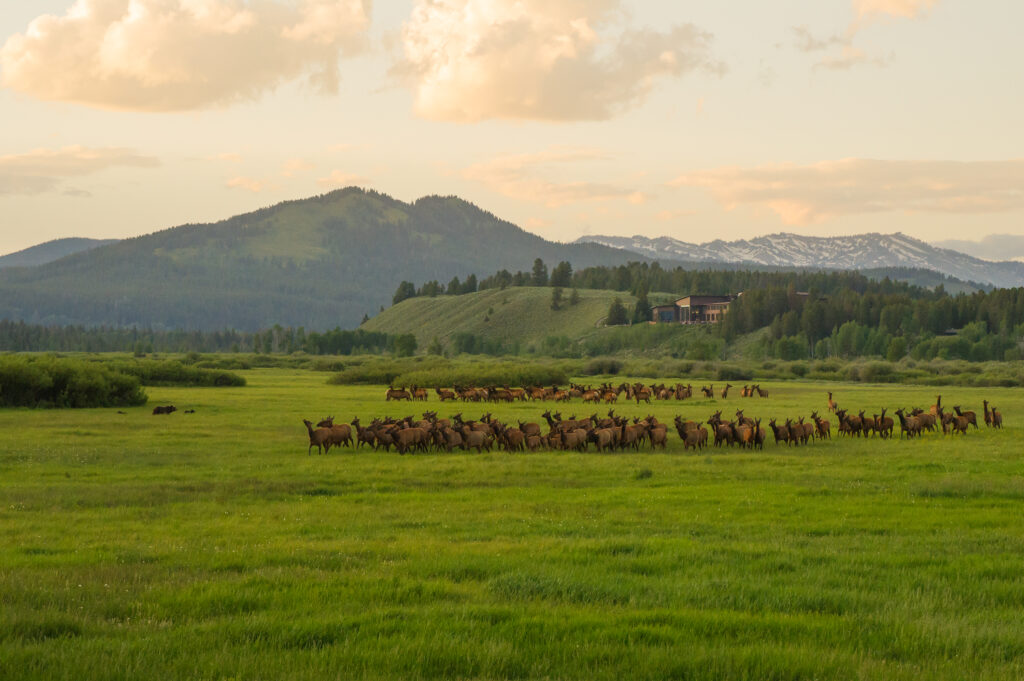
“There’s a lot of debate about the present state of the bear population. I’ve extensively read the analyses compiled by Dr. Dave Mattson who spent many years as a researcher with the federal grizzly bear study team,” Mangelsen says. “Mattson points to claims being made by the states that bear numbers are exploding, that Yellowstone is bursting at the seams. But Dave disputes the argument. He says bears are distributing themselves across wider areas of the landscape that gives a false impression. They’re ranging further in search of high quality foods. In fact, in the center of the ecosystem, he notes that the trendline for the bear population is generally flat. The problem is that as bears venture out farther from core public land protected areas they are coming into places where there are a lot of people and that means more bears are going to die, not prosper. Rather than painting an optimistic picture, as the states are doing, it’s actually kind of the opposite. Wyoming wants to keep grizzlies confined to a relatively small box of space, just like they’re doing with wolves. The state is going to stunt recovery, not build on the success that has been achieved.”
Biological recovery hinges on the convergence of several stable factors: reducing excessive and preventable human-caused mortalities, maintenance of good habitat, healthy reproduction, room for the bear population to expand into available habitats, , bear friendly state laws, lack of devastating diseases, human tolerance, and keeping conflicts to a minimum. Related to each of these, Servheen says the two critical watchwords are growing uncertainty. Concerns about the negative impact of human population growth and its related expanding human footprint on private lands are today top of mind in ways they were not in the mid 1990s. Ironically, they aren’t even being considered in the calculation of forward-looking biological recovery. This absence represents both a major blind spot and a deficiency of the current Endangered Species Act.
More than a dozen years ago, Chuck Schwartz was co-author of a number of scientific analyses on habitat loss. One startling revelation was that a grizzly bear would exhibit avoidance behavior on a section of land—360 acres—if there was a single house and infrastructure in the center of it. By doing simple extrapolation, it’s not difficult to surmise the impact on grizzlies (and other wildlife) with the approval of just one new 20-unit residential subdivision in a rural corner of Greater Yellowstone. Grizzlies are both an indicator and umbrella species, in that habitat that is protected for their survival benefits at least 230 other species.
When Schwartz and I spoke, after going over his scientific papers, he pointed to developments like Big Sky, Montana as being a “black hole” for bears. “Bears might wander into the development but there’s a high chance they’ll get into conflict and not come out alive.” Since Schwartz’s paper was published, the human footprint of Big Sky has doubled or tripled and the real estate speculators/developers/construction industry executives who are rapidly pushing Big Sky toward build out have exhibited no sign of restraint; nor, for that matter, much if any concern about the negative impacts development has inflicted on wildlife and habitat. There have been few conservation groups calling them out, scrutinizing each new luxury lodge or paying attention to cumulative effects.
Back in Jackson Hole, 399 is rapidly approaching the end of her natural life. And the good news is that a healthy population of grizzlies exists and there’s a large devoted community of bear advocates in place. But will their vigilance last, and will they also channel their energies into demanding better wildlife-friendly planning and zoning applied to the last best tracts of private land habitat? Will they help lead discussions about the need for limits on visitation and use of the backcountry? If they do not, the great progress that has been made for grizzly conservation during the life of 399 could prove to be a short-term mirage.
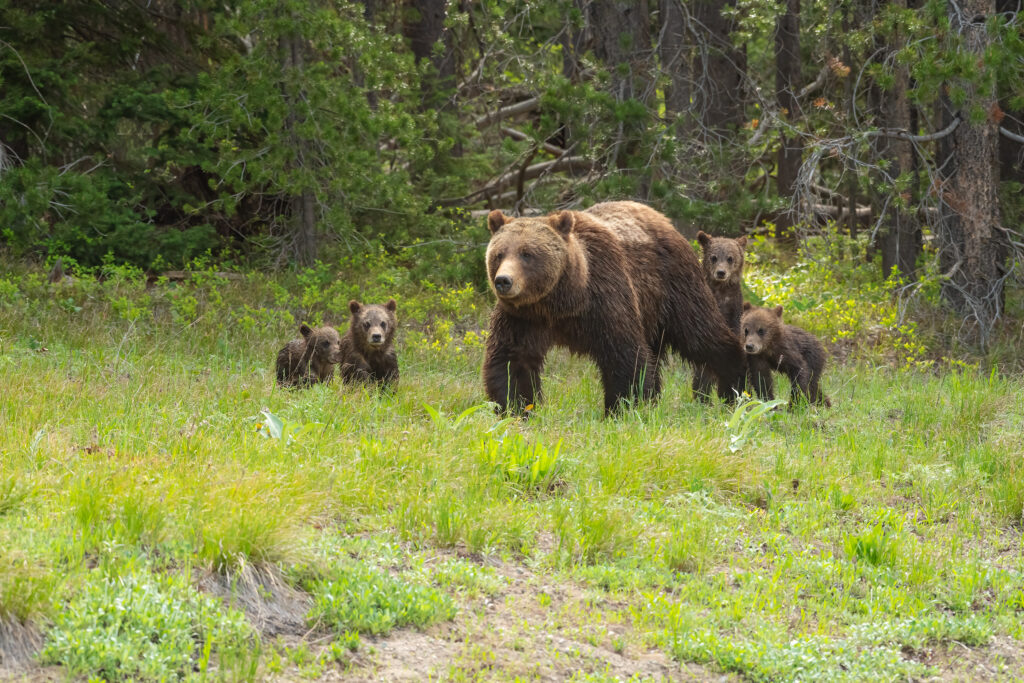
399 has been a catalyst for a lot of enlightenment. The first book that Mangelsen and I collaborated on, a book featuring his photographs titled “Grizzlies of Pilgrim Creek,” sat for years in the waiting area of two different Interior Secretaries—Ken Salazar who was appointed by Barack Obama and Ryan Zinke and David Bernhardt served under Donald J. Trump. Copies were also in the office of differing National Park Service directors. Locally, in Jackson Hole, the huge public interest in 399 prompted Grand Teton Park to innovatively create a unit of volunteers and park employees called “the Wildlife Brigade” whose mission is to educate the public and keep people at safe distances. What they do is often a thankless task. The same applies to the many people from differing government agencies tasked with trying to bring calm to the commotion roadside bears generate.
Mangelsen has helped me an assemble a list of the many dozens of people who have become ardent 399 watchers and advocates and he praises them all. I am not publishing the list here because I do not wish to offend anyone who might feel slighted, but suffice it to say, it’s long and includes both permanent residents of Greater Yellowstone and visitors. Mangelsen, Servheen, Cedarholm, Sandy Mell and Greg Balvin are featured in a new documentary 399: Queen of the Tetons that is airing on PBS channels May 8 and there will be two showings at the Jackson Hole Center for the Arts on May 22. Mangelsen and I will be there with the producers and others to talk about 399 and the film directed by Elizabeth Leiter.
“To me 399 is one of the best examples of the dividends of re-wilding. It’s not abstract. She’s been right in front of us. When we think about the intrinsic value of wildlife, she has made it very real to understand. She doesn’t realize it, but she’s been a great educator. And why have so many of us become such outspoken protectors? It’s not only because we’ve grown fond of her and her cubs, but we’re grateful because she has enlivened our lives and reminded us of the joy of being here. She can’t show up at a public meeting and advocate for herself. She can’t show up at a Wyoming Game and Fish Commission meeting and plead, ‘Please don’t allow people to shoot me and leave my cubs orphaned.’ She can’t put a Go-Pro camera on her head and give us a heart-palpitating glimpse at all of the stressful things she encounters. But we can give her a voice, and I think that’s what has really motivated the people who care. They realized that it takes an army of we humans to help keep a bear like her alive but only one boneheaded move by a single individual that can result in her death.”
“When we think about the intrinsic value of wildlife, 399 has made it very real to understand. She doesn’t realize it, but she’s been a great educator. And why have so many of us become such outspoken protectors? It’s not only because we’ve grown fond of her and her cubs, but we’re grateful because she has enlivened our lives and reminded us of the joy of being here. She can’t show up at a public meeting and advocate for herself. She can’t show up at a Wyoming Game and Fish Commission meeting and plead, ‘Please don’t allow people to shoot me and leave my cubs orphaned.’ She can’t put a Go-Pro camera on her head and give us a heart-palpitating glimpse at all of the stressful things she encounters. But we can give her a voice.”
—Thomas D. Mangelsen
As captivating as 399 and her cubs have been, there is, right now, a version of 399 in many of the river drainages rising in the core of Greater Yellowstone as part of the headwaters of the Yellowstone-Missouri, Snake-Columbia and Green-Colorado river systems. Yes, tens of millions of humans downstream in distant cities who draw their tap water from the rivers, can gain inspiration knowing that a wild grizzly might have splashed through that aqua. Yet, as history demonstrates on a daily basis, wildness is in retreat and no wildlife conservation effort is guaranteed without continuous vigilance, human self-restraint when it comes to usurping habitat, and employing the tenets of the precautionary principle which is that the impacts of consequential decisions be considered before they are approved and implemented.
Why do we as a society spend billions of dollars (if you include efforts in restoring the Florida Everglades and re-retrofitting or removing dams for salmon) resuscitating the fortunes of wildlife, bringing species back from the brink of winking out or restoring them through re-wilding? Sit with the question. America is a leader in the world and other nations hold us up as a beacon yet in the Northern Rockies today our approach is sometimes interpreted as being schizophrenic.
Mangelsen asserts that it’s insulting to the dignity of bears and a degradation of the spirt of the Endangered Species Act to treat grizzlies as “surplus animals” that every autumn can be “harvested like stalks of corn” and “turning what was a living breathing intelligent animal with emotions into a rug or mounted head on the wall.” He says it makes no sense that a public live bear which has delighted thousands or millions of people into a personal trophy that, with its death, becomes possessed and privatized by a single individual. He doesn’t like distilling the “worth” of animals down to economics, but he says that grizzlies are worth a lot more live than dead.
The contrast is compelling. In an average year, Yellowstone and Grand Teton national parks generate upwards of $1.5 billion in economic activity that benefits the region. The commerce creates 15,000 jobs. One study in Yellowstone showed that two of the top three park attractions are bear and wolf watching. In Jackson Hole, it would be inordinately difficult to challenge the fact that the mystique of 399 and other bears is a magnet for more nature-tourism spending, in an single year, than the total cost of grizzly bear management the state of Wyoming has assumed—the figure is pegged at around $70 million—going back to 1975. Servheen says the claim that grizzly recovery has imposed a major economic burden upon the three Northern Rockies states is an exaggeration and instead recovery ought to be a source of pride and celebration, not a burden or treated as a nuisance. The economic and emotional benefits coming from grizzly bears far outweigh the management costs of the states.
Together with leaders from the major public land agencies comprising Greater Yellowstone—the US Forest Service, National Park Service, US Fish and Wildlife Service and Bureau of Land Management—grizzly conservation did not come as a huge expense to the oil and gas, timber, livestock and mining industries. It did not result in major job losses nor a large number of human injuries and deaths, considering the millions of people who pass through it. Among the huge upsides directly linked to grizzly conservation: better trash sanitation standards and clean camp requirements that have reduced food conditioning problems for many species and better transboundary coordination between agencies. The grizzly, in fact, is the very fulcrum for revolutionary ecosystem-wide thinking that has been adopted by other regions and nations.
Regarding hunting, it is a social, cultural and political question, not a biological one, Servheen says. The biology does not support the contention that grizzlies need to be hunted. How it is contemplated is a reflection of the values of those in office and the citizens who elect them. Some in the states of Wyoming, Montana and Idaho claim that “grizzlies need to be managed” and that trophy hunting is the best way to accomplish that. In fact, bears have been managed, rather well, actually, going back to the time they were listed and that management resulted in a growing population. It has allowed for removing so-called “problem bears” [which usually only get into trouble because of human activity] and they’ve worked in creating a safer environment for both bears and people.
Servheen, who is an elk hunter, says that hunting is not a sound management tool for grizzlies. It’s like a blunt instrument being used for a kind of recovery that needs ongoing surgical precision. If hunting returns, Mangelsen claims, it will inevitably result in grizzlies being killed legally in sport hunts managed by the states, with others because they are mistaken for black bears. Along with this, females of prime reproductive age will also be killed and cubs orphaned, bears will be wounded that then become safety hazard to humans, and there will likely be more indiscriminate killing, a potential rise in poaching, and a continuous public outrage. “Why would any state want to deliberately do something that right out of the gate would taint its reputation and make it look crass and backward in the eyes of the larger public?” Mangelsen asks.
Hunting will not “balance grizzly bear numbers with their habitat, will not reduce depredations against private property and will not reduce human fatalities due to grizzly bear attacks,” Servheen notes, and spelled out the same points in a letter sent to the Montana Fish and Wildlife Commission.
Servheen, who is an elk hunter, says that hunting is not a sound management tool for grizzlies. It’s like a blunt instrument being used for a kind of recovery that needs ongoing surgical precision. “Hunting will not ‘balance grizzly bear numbers with their habitat,’ will not reduce depredations against private property and will not reduce human fatalities due to grizzly bear attacks,” he says.
Another criticism that has been advanced, not mentioned by Servheen, is that states may be incentivized to not be as aggressive as they ought to be in enacting laws intended to prevent human-bear conflicts, so that more bears would ostensibly be available for hunters. Citing the recent wolf incident in Sublette County, Wyoming in which a wolf was allegedly and legally run down by a snowmobiler, captured live, brought to a saloon with its muzzle duct taped, fitted with a shock collar and then killed, Wyoming is now under intense scrutiny which has spilled over to its claims it will responsibly manage bears if they are delisted, Mangelsen says.
In 2018, before US District Court Judge Dana Christensen ordered that bears be re-listed and halted a proposed sport hunting season in Wyoming, the state had set a quota of 22 grizzlies in the first hunt staged since 1974. Today, conservative politicians from the West are making legislative attempts to force grizzlies to be taken off the list of federal protection, with management handed over to states which are eager to bring back hunting. Since then, Wyoming has revised upward the number of bears it would allow hunters to take and that would be on top of dozens of bears that already die every year in Greater Yellowstone from accidents, removals and run-ins with elk hunters.
In 2023, Mike Koshmrl, a reporter with Wyofile, interviewed Dan Thompson, who leads the large carnivore section of Wyoming Game and Fish and is the point person in determining a grizzly hunting quota. As with wolves, Wyoming has crafted zones that allow it to approach conservation priorities for bears very differently. Inside the arbitrary boundary of a zone that basically encompasses Yellowstone and Grand Teton (where hunting is now allowed) and including adjacent wilderness areas, there will be a mandated effort, based on an agreement the state struck with the US Fish and Wildlife Service, to maintain a population of bears. Thompson told Koshmrl that, based on estimates of the Greater Yellowstone bear population in 2021, Wyoming theoretically could allow hunters to kill 10 female bears and 19 males in its first hunting season inside what’s called the “demographic monitoring area” (DMA).
The only problem is that this priority conservation zone largely adheres to the boundaries of habitat that bears occupied in 1975 when they were listed. And it’s too small to maintain a viable larger population that can endure. But east of the national parks and just south of Jackson Hole, beyond the DMA, the state has created a zone that allows far more leniency in lethal removal of “problem bears” and it is largely based on Wyoming’s cryptic, poorly defined notion of “low social tolerance.” That means that more bears could be legally killed. Even on federal public lands, even if a grizzly does not have conflicts with people or livestock, more bears in that zone will be available for removal by hunters. A question that’s been unanswered is why? And who determines what tolerance for grizzlies is or isn’t? It is far more expensive to manage hunting than to nurture better co-existence and conflict prevention. No matter how much revenue Wyoming generates from selling hunting tags the amount doesn’t come close to money generated from eco-tourism.
Sublette County, Wyoming, the Wind River Range, the Wyoming Range and the Salt River Range that are important wild areas in the southern half of the Greater Yellowstone Ecosystem are classified as low human tolerance zones for grizzlies, though there is an abundance of quality bear habitat.
There is a flashpoint for pondering the real-world implications of where grizzlies fit into the clash between the Old and New West. In 2019, the US Forest Service re-approved new livestock grazing allotments in the Bridger-Teton, situated in the headwaters of the Green and Gros Ventre rivers and parts of two designated wilderness areas. The US Fish and Wildlife Service had to sign off on the plan because having cattle in the same vicinity as grizzlies would likely result in bear deaths. The Service gave it approval, allowing for up to another 72 grizzlies to be killed in order to reduce predation on cattle.
The Center for Biological Diversity, Sierra Club, Western Watersheds Project, Alliance for the Wild Rockies, and Yellowstone to Uintas Connection sued, saying that allowing such a large number of public bears to be killed on public land to protect private cattle, was unacceptable. And they won a victory in the US Tenth Circuit Court, which said the Bridger-Teton had violated its own forest plan which claimed it would give highest priority to perpetuating the survival of native wildlife. The issue is still festering.

Servheen did not comment on the court case but he did say having safe quality habitat on public lands for bears will likely become even more crucial to bear conservation in the years and decades to come as private lands, formerly available for bears to pass safely through, fill up with sprawl. Sprawl is rapidly expanding in the area around Hoback Junction, between Pinedale and Bondurant, Star Valley, and Alpine. This is why Servheen, who formerly was optimistic about bear recovery and supported delisting, is much more cautious and skeptical about the state’s willingness to adopt flexible policies that emphasize bear conservation over bear removal.
Servheen says humans like to fixate on numbers, which can be an important metric in calculating profit or loss, progress or decline, success or failure. When it comes to grizzlies, the number of bears at a given moment is less instructive than assessing acres and square miles of secure habitat that can reliably support a stable population indefinitely—and buffer against deleterious effects of development and simply large numbers of people moving through landscapes which inevitable results in a lower carrying capacity for bears. Yes, there are five or six times the number of grizzlies in Greater Yellowstone now than when the population dipped to its nadir, but recovery demands doing an honest assessment about habitat trends. If one does that, and honestly acknowledges that counties through lax planning and zoning have allowed sprawl to explode largely unchecked, the expanding bear population is running into unceasing waves of human pressures and permanent impacts that do not bode well with bears.
Servheen originally was one of those who said the public needs to understand that agencies do manage for populations and not for individuals but he has developed his own fondness for 399 because her longevity has enabled the public to gain a better understanding and appreciation for grizzlies that didn’t exist before. Mostly, he wants citizens to empathize with the challenges they face .
399 is the most famous living mother bear in the history of our planet but only humans value such kinds of distinction collectively. In terms of her celebritydom, it’s not something she ever courted or curated; she is the opposite of the shallow artifice residing in the Kardashians, or the control nature-symbolism of captive bruin Smokey left orphaned by a forest fire, or the made for Hollywood popularization of Elsa the lioness.
399 is the most famous living mother bear in the history of our planet but only humans value such kinds of distinction collectively. In terms of her celebritydom, it’s not something she ever courted or curated; she is the opposite of the shallow artifice residing in the Kardashians, or the control nature symbolism of captive bruin Smokey left orphaned by a forest fire, or the made for Hollywood popularization of Elsa the lioness.
What 399 is, as a wild, self-willed, attentive mother is something special worth savoring. She’s also a symbol of co-existence that is exceedingly fragile and breakable.
She and other grizzlies are, every day, at the mercy of humans who must behave responsibly, refrain from doing dumb, lazy impetuous things, be it being sloppy with our food, invading their comfort zones and safe spaces, hunters not attending to big game carcasses, letting our dogs chase wildlife, driving too fast, not carrying bear spray, or thoughtlessly building homes in vital habitat and not bothering to reflect on our own taking at the expense of others.
The real legacy of 399 centers on a question she has presented to us: do we want to have wild places? Do we want to be part of the solution or the problem? Do we want to give grizzlies the best chance they can to persist? Or, do we want to return to the bad old days of yore when pretty public landscapes were stripped of their living, breathing moving parts?
399 is a mirror. When you gaze at her, what do you see in the reflection?
NOTE: Listen to the podcast by Jake Nichols of Cowboy State Daily who invited us to discuss the passing of 399 and what she meant for grizzly bear conservation.
Subscribe
Never miss a story, subscribe to our newsletter!



